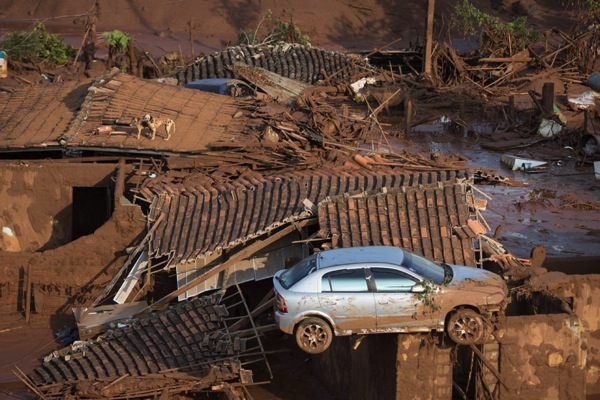Brazil mine accident puts tailings ponds safety back in the hot spot

 The next time a mining company decides against dry-stacking as a too-costly alternative to tailings ponds, its directors and shareholders may want to consider what a tailings pond breach could cost companies like Imperial Metals Corp. (TSX:III) or BHP Billiton Ltd. (NYSE:BHP).
The next time a mining company decides against dry-stacking as a too-costly alternative to tailings ponds, its directors and shareholders may want to consider what a tailings pond breach could cost companies like Imperial Metals Corp. (TSX:III) or BHP Billiton Ltd. (NYSE:BHP).
Up until November 5, the August 4, 2014, tailings pond failure at Imperial's Mount Polley copper mine had been the worst such breach at a mine in recent years.
It was eclipsed when two tailings ponds at Samarco's large iron ore mine gave way, flooding the town of Bento Rodrigues, Brazil, with water and mine slurry. At least eight people were reported dead last week, and more than 20 missing and presumed dead.
The financial toll for BHP Billiton and Vale SA (NYSE:VALE), which are partners in the Samarco joint venture in Brazil, will not be known for some time.
But it is likely to far exceed that of the Mount Polley disaster, which has cost Imperial Metals $61 million to date in rehabilitation, according to recent financials, plus a full year of lost production and a single-day market capitalization loss of 40% following the news of the collapse.
The Samarco mine disaster was the second fatal dam breach in Brazil in little over a year. In September 2014, a tailings pond dam breach killed three people at another nearby mine, the Herculano Minera????o.
"So within 14 months, you have two tailings pond breaches - multiple fatal tailings pond issues - and the regulators are in full crisis recovery mode," said Cameron Stockman, North American business development manager for CEC Mining Systems, which recently built a new dewatering plant for a small mine just 25 kilometres from the Samarco operation. "Whether Samarco will ever come back online, who knows?"
Vancouver's CEC is one of a handful of companies that specialize in tailings dewatering technology. It is currently building dewatering plants for two new mines in Mexico and Chile.
Waste ore from mines is most often stored underwater in large holding ponds to prevent the oxidization that can cause acid rock drainage and other problems. The alternative is dry-stacking, which reduces a mine's water consumption and prevents potentially catastrophic floods from collapsing tailings pond dams.
The mining process uses water, so mine waste is wet and needs to be dewatered before it can be stored in dry heaps until it can go back into a pit or shaft as part of mine reclamation.
It is an energy-intensive process that typically involves squeezing the water from the wet waste ore. CEC uses a vacuum process that it claims is much more energy-efficient.
But even with CEC's lower energy requirements, dry-stack technology has higher capital costs than traditional tailings ponds. And in high-rainfall areas like B.C., dry-stacking isn't feasible in many cases. Moreover, most mines in B.C. are in remote areas, which reduces the potential for a tailings pond breach to flood towns and cities.
One notable exception is the proposed Ajax mine, a large open-pit copper-gold mine that would be partially located within the city limits of Kamloops. With an annual production of 60,000 tonnes, it would be on a scale similar to Mount Polley.
KGHM International Ltd., the company developing the mine, has considered dry-stacking its tailings, but documents filed with the B.C. Environmental Assessment Office (EAO) indicated the company favoured using a tailings pond. That has raised concerns with the City of Kamloops.
"In light of the significant issues with the Mount Polley tailings impoundment, the move to a conventional tailings system in the Ajax project is concerning," the city writes in a submission to the EAO.
A company spokesman, Robert Koopmans, said KGHM has settled on a compromise - a thickened tailings pond. That process involves removing some of the water, something the company hopes will reduce concerns about the potential for spills.
Stockman said his company sees an uptick in calls from mining companies every time there is a tailings pond breach, but so far it has received no contracts to build a dewatering plant in B.C.
Following the Mount Polley disaster, the B.C. government introduced new regulations requiring new mine projects to consider alternatives to tailings ponds.
Stockman said he thinks many of the inquiries his company gets for B.C. mine projects are not much more than "lip service to compliance so they could check the boxes for the provincial regulators."
But he does not believe that dry tailings management should be mandatory in B.C., because he acknowledges that it simply isn't viable in some cases for technical and geotechnical reasons.
Yet he thinks mining companies need to consider the longer-term payoffs of moving to dry-stacking.
While it may have higher upfront costs, it can be a lot less costly when the bills start coming in after a tailings pond disaster. He added that it can go a long way to obtaining environmental and social licence.